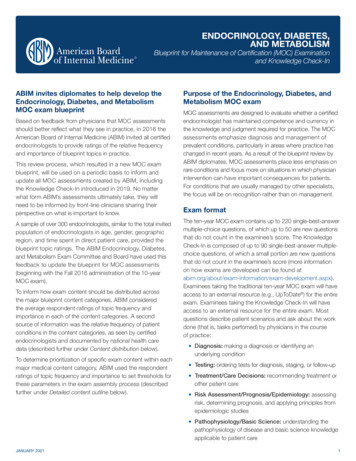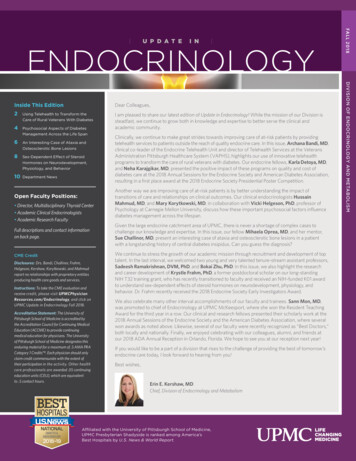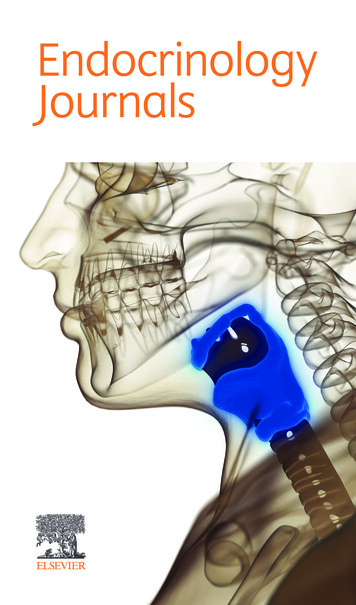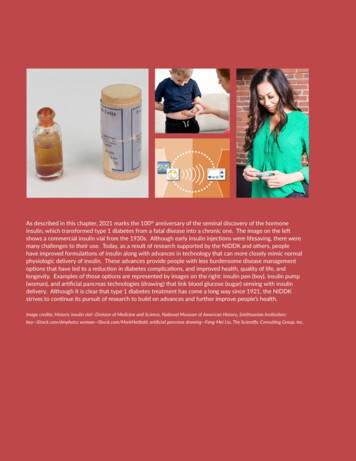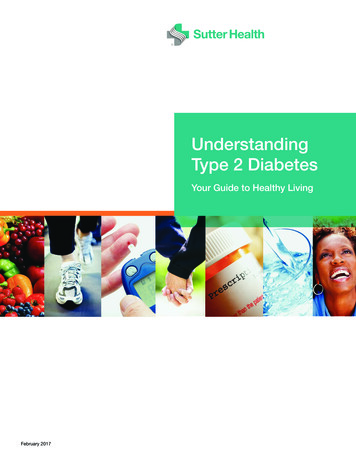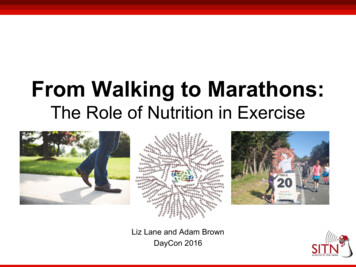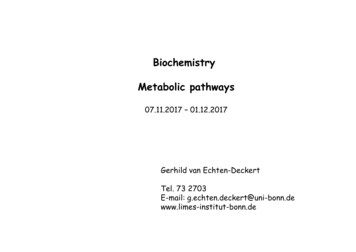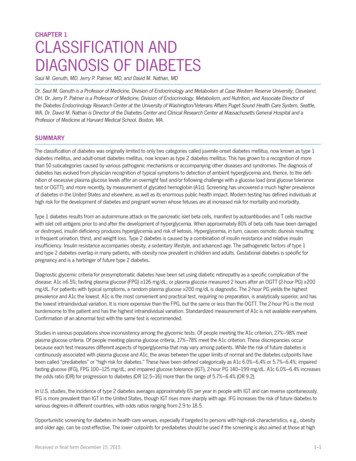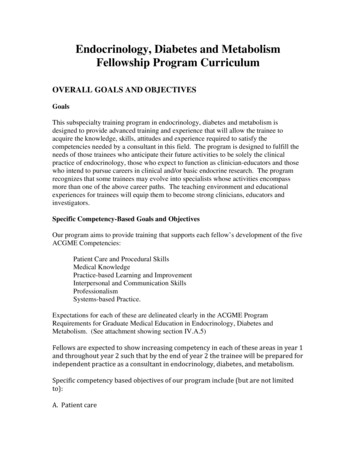
Transcription
Endocrinology, Diabetes and MetabolismFellowship Program CurriculumOVERALL GOALS AND OBJECTIVESGoalsThis subspecialty training program in endocrinology, diabetes and metabolism isdesigned to provide advanced training and experience that will allow the trainee toacquire the knowledge, skills, attitudes and experience required to satisfy thecompetencies needed by a consultant in this field. The program is designed to fulfill theneeds of those trainees who anticipate their future activities to be solely the clinicalpractice of endocrinology, those who expect to function as clinician-educators and thosewho intend to pursue careers in clinical and/or basic endocrine research. The programrecognizes that some trainees may evolve into specialists whose activities encompassmore than one of the above career paths. The teaching environment and educationalexperiences for trainees will equip them to become strong clinicians, educators andinvestigators.Specific Competency-Based Goals and ObjectivesOur program aims to provide training that supports each fellow’s development of the fiveACGME Competencies:Patient Care and Procedural SkillsMedical KnowledgePractice-based Learning and ImprovementInterpersonal and Communication SkillsProfessionalismSystems-based Practice.Expectations for each of these are delineated clearly in the ACGME ProgramRequirements for Graduate Medical Education in Endocrinology, Diabetes andMetabolism. (See attachment showing section IV.A.5)Fellows are expected to show increasing competency in each of these areas in year 1and throughout year 2 such that by the end of year 2 the trainee will be prepared forindependent practice as a consultant in endocrinology, diabetes, and metabolism.Specific competency based objectives of our program include (but are not limitedto):A. Patient care
The program will provide training in diagnosis and management of endocrinediseases including:1. History and physical examination with emphasis on examination of thethyroid, feet, breast, and male and female reproductive organs and otherphysical exam elements specific to endocrine disorders2. Selection and interpretation of endocrine biochemical tests3. Selection and interpretation of imaging procedures such as sonography,radionuclide scans, computerized axial tomography, magnetic resonanceimaging, positron emission tomography, etc.4. Performance of Fine needle aspiration of the thyroid and interpretation ofcytology and pathology (year 2).5. Management of insulin pump therapy in patients with diabetes mellitus andinterpretation of continuous glucose monitor downloads.6. Appropriate use and interpretation of skeletal dual photon absorptiometry.7. Understanding pharmacotherapy for endocrine disorders and appropriateuse of surgery, radiation therapy, treatment with radioisotopes, etc. ofrelevant endocrine disorders.8. Selection and management of patients for whole organ or islet celltransplantation.B. Medical Knowledge.The program will provide training in:1. Endocrine biochemistry, genetics, developmental biology, physiology andpathophysiology.2. Hormone action including signal transduction pathways as well as thebiology of hormone receptors and feedback inter‐relationships3. Diagnosis and management of disorders in endocrinology, diabetes andmetabolismDetails of the scope of medical knowledge expected to be gained by fellows isdelineated in the Program Curriculum which can be found on our program webpage.C. ProfessionalismThe program will provide training in professionalism, including peer interactions,communication with patients, their families and other health care providers,confidentiality and avoidance of conflict of interest. Professional behavior will bedemonstrated by faculty in the program and expectations are also set out duringfellow orientation.D. Practice‐Based Learning
1. The trainee will begin a clinical or basic research project in Endocrinology,Diabetes and Metabolism in year 1, and provide a written report and oralpresentation of rationale and results by the end of year 2.2. The program will provide training in the understanding of existing andemerging endocrine literature.3. Ongoing mentoring and semi‐annual reviews will encourage self‐reflection and personal goal setting on the part of the fellow.E. Systems‐Based Learning1. The program will provide training in the transition of diabetes carebetween the outpatient and inpatient settings.2. The trainees will participate in quality improvement projects andcommittees during their training.
ADRENALINTRODUCTIONA complete understanding of normal physiology and the pathologic diseases affecting the adrenalgland is essential for the endocrinologist and should be part of education curriculum and trainingfor fellows. Adrenal disorders can originate at various functional levels (e.g., hypothalamus,pituitary, adrenal) and be caused by genetic or environmental factors. Adrenal disorders may beassociated with overproduction or underproduction of adrenal hormones and/or nonfunctioning(benign or malignant) neoplastic lesions. Comprehensive appreciation of adrenal pathophysiologyalso includes recognizing how adrenal dysfunction affects other body systems, including thepotential effects on endocrine and nonendocrine systems (e.g., metabolic, musculoskeletal,dermatologic, cardiovascular), some of which may be life-threatening. Fellows should becompetent in the diagnosis and treatment of adrenal disorders.MEDICAL KNOWLEDGEFellows must demonstrate knowledge about established and evolving biomedical, clinical, andcognate (eg, epidemiological and social-behavioral) sciences and the application of thisknowledge to patient care.TopicFundamentalAdvancedBASIC PHYSIOLOGIC PRINCIPLES, ADRENAL BIOLOGYExplain adrenal gland embryology, anatomy, and zonation. Describe steroid biosynthetic pathways, including specific enzymatic steps. Describe steroid metabolism. Explain regulation of the hypothalamic-pituitary-adrenal axis, includingnormal patterns of corticotropin and cortisol secretion.Describe the renin-angiotensin-aldosterone system and regulation ofmineralocorticoid secretion. Explain regulation of adrenal sex steroid production, secretion, and extraglandular metabolism of adrenal sex steroids.Describe catecholamine biosynthesis, secretion, and metabolism. List factors that affect measured levels of adrenal regulatory hormones (eg,corticotropin, renin), steroids, and catecholamines and their metabolites (eg, in plasma, urine, and saliva).Explain the molecular and cellular mechanisms, as well as physiologiceffects, of glucocorticoids, mineralocorticoids, sex steroids, andcatecholamines.
GLUCOCORTICOIDSCushing SyndromeClinical PresentationSummarize the symptoms and signs of Cushing syndrome resulting fromchronic exposure to excess glucocorticoid, including progressive obesity,dermatologic manifestations, menstrual irregularities, signs of adrenalandrogen excess, proximal muscle wasting and weakness, bone loss, glucose intolerance, cardiovascular disease, thromboembolic events,neuropsychological changes and impaired cognition, and infection andimpaired immune function.Differential Diagnosis (Adrenal vs Ectopic vs Pituitary vs Exogenous vs Physiologic)Perform the differential diagnosis of Cushing syndrome to determine thesource of cortisol excess, which could be adrenal, ectopic, or pituitary. Diagnostic TestsSelect and interpret results from appropriate case-detection (screening)tests, which may include measurement of 24-hour urinary cortisolexcretion, late-night salivary or serum cortisol measurement, or 1-mg overnight dexamethasone suppression.Select and interpret results from appropriate diagnostic tests to determinethe source of glucocorticoid excess, which may include measurement ofcorticotropin, inferior petrosal sinus sampling, diurnal serum cortisolmeasurement, corticotropin-releasing hormone stimulation testing, vasopressin stimulation testing, and/or dexamethasone suppressiontesting (with or without corticotropin-releasing hormone).Discuss the diagnostic challenge of glucocorticoid excess in the setting of pregnancy.Determine when genetic testing is appropriate in the setting of familial hypercortisolism.Select the appropriate imaging modality on the basis of the biochemicalprofile. Exogenous Cushing Syndrome (Iatrogenic or Factitious)Obtain a careful history to evaluate for exogenous glucocorticoid intake asthe source of hypercortisolism (eg, prescribed glucocorticoid,surreptitious intake of glucocorticoid, medications that decreaseglucocorticoid metabolism).Pseudo-Cushing Syndrome
Distinguish physiologic hypercortisolism that can occur in disorders otherthan Cushing syndrome (eg, in patients with physical or psychological stress, severe obesity, malnutrition, or chronic alcoholism) from Cushingsyndrome itself.Adrenal NeoplasmEvaluate for adrenal adenoma, carcinoma, and micronodular andmacronodular hyperplasia. Ectopic Corticotropin/Corticotropin-Releasing HormoneEvaluate for tumors associated with the ectopic ACTH (corticotropin)syndrome or the ectopic CRH (corticotropin-releasing hormone) syndrome.TreatmentDepending on the etiology of Cushing syndrome, recommend the bestinitial treatment, which may include cessation of exogenous glucocorticoid, surgical excision of tumors, unilateral or bilateraladrenalectomy, or in certain circumstances, medical therapy.Recommend appropriate long-term management depending on the initialtreatment strategy and resolution of signs and symptoms, which mayinclude postoperative glucocorticoid therapy, mineralocorticoid replacement, medical therapy, as well as therapy for associatedcomplications (osteoporosis, etc).Adrenal InsufficiencyPrimary Adrenal InsufficiencySummarize the symptoms and signs of acute adrenal crisis, includingshock, abdominal tenderness, fever, weight loss, and electrolyte abnormalities.Summarize the symptoms and signs of chronic primary adrenalinsufficiency, including signs of glucocorticoid, mineralocorticoid, andandrogen deficiencies; chronic malaise; lassitude; fatigue; generalized weakness; anorexia; weight loss; gastrointestinal complaints; psychiatricmanifestations; hypotension; hyperpigmentation; vitiligo; electrolyteabnormalities; and hypoglycemia.Recognize that adrenal insufficiency can be a sign ofadrenoleukodystrophy. Recommend treatment approaches for acute adrenal crisis and chronicadrenal insufficiency, which includes choice of glucocorticoid and the appropriate regimen and mineralocorticoid replacement.Secondary/Tertiary Adrenal InsufficiencySummarize the symptoms and signs of secondary adrenal insufficiency,which are similar to those of primary adrenal insufficiency (except for
the absence of hyperpigmentation, dehydration, and hyperkalemia) andwhich may include severe headache and/or vision disturbances and/orcranial nerve abnormalities.Evaluate for other pituitary hormone deficiencies in patients withsecondary adrenal insufficiency.Recommend treatment approaches for secondary adrenal insufficiencydepending on etiology. DiagnosisGuide the diagnosis of adrenal insufficiency, which may includemeasurement of cortisol, corticotropin, renin, and aldosterone;corticotropin stimulation test; metyrapone test; insulin-induced hypoglycemia test, and corticotropin-releasing hormone test.Glucocorticoid TherapyDescribe glucocorticoid and mineralocorticoid efficacy ofpharmacologically available agents (hydrocortisone, prednisone, dexamethasone, etc).Guide appropriate tapering regimens for cessation of glucocorticoids. Diagnose steroid withdrawal syndrome. Stress DosesRecognize the importance of medical alert identification. Outline sick-day protocols with increased oral dosages of glucocorticoid. Guide the use of parenterally administered glucocorticoids for adrenalcrisis or surgical procedures. Glucocorticoid ResistanceSummarize the symptoms and signs of glucocorticoid resistance, includinghypertension and hypokalemic alkalosis, hirsutism, male-patternbaldness, menstrual abnormalities and infertility in females, isosexual precocious puberty, and abnormal spermatogenesis and infertility inmales.Recommend management approaches for glucocorticoid resistance. MINERALOCORTICOIDSHyperaldosteronismPrimary HyperaldosteronismSummarize the symptoms and signs of primary aldosteronism, includinghypertension, variable presence of hypokalemia, and lack of edema.
Distinguish between the most common subtypes of primaryhyperaldosteronism—aldosterone-producing adenomas and bilateral adrenal hyperplasia.PseudohyperaldosteronismDifferentiate among other causes of hypertension and hypokalemia suchas Liddle syndrome, licorice ingestion, 17 -hydroxylase deficiency/17,20- lyase deficiency, and 11 -hydroxylase deficiency.Diagnostic TestsRecommend case-detection testing in appropriate patients (those withhypertension and hypokalemia, severe hypertension or drug-resistanthypertension, hypertension with adrenal incidentaloma, hypertension and family history of early-onset hypertension, all hypertensive firstdegree relatives of patients with primary aldosteronism).Explain the initial case-detection approach (plasma aldosteroneconcentration, plasma renin activity, and ratio of plasma aldosterone concentration to plasma renin activity).Differentiate among the tests used for diagnosis confirmation (salineinfusion test, oral sodium loading, fluorocortisone suppression test, captopril challenge test).Describe the tests used for subtype diagnosis, including adrenal computedtomography and adrenal venous sampling. Determine when genetic testing is appropriate in the setting of familial hyperaldosteronism.TreatmentRecommend treatment strategies for hyperaldosteronism, which mayinclude laparoscopic adrenalectomy, mineralocorticoid receptor antagonist therapy, and potassium-sparing diuretics.Manage hyperaldosteronism in the context of pregnancy. HypoaldosteronismSummarize the clinical manifestations of hypoaldosteronism, includinghyperkalemia and mild hyperchloremic metabolic acidosis. Differentiate among disorders of reduced aldosterone production (eg,hyporeninemic hypoaldosteronism, primary adrenal insufficiency,congenital isolated hypoaldosteronism, pseudohypoaldosteronism type 2) vs aldosterone resistance (eg, potassium-sparing diuretics, antibiotics,pseudohypoaldosteronism type 1).Recommend appropriate diagnostic testing, including measurement ofplasma renin activity, serum aldosterone, and serum cortisol afteradministration of a loop diuretic.
Recommend treatment strategies for hypoaldosteronism, which mayinclude mineralocorticoid therapy and glucocorticoid therapy, depending on the cause of the hormone deficiency.ADRENAL ANDROGENSCongenital Adrenal HyperplasiaDifferentiate among the 3 main phenotypes of 21-hydroxylase deficiency:classic salt-losing, classic non–salt-losing, and nonclassic (late-onset).Explain the genetics of 21-hydroxylase deficiency due to CYP21Amutations. Differentiate among the less common forms of congenital adrenalhyperplasia due to 11 -hydroxylase deficiency, 17 -hydroxylase deficiency/17,20-lyase deficiency, and 3 -hydroxysteroid dehydrogenasedeficiency.Guide the diagnosis of congenital adrenal hyperplasia with measurementof 17-hydroxyprogesterone and electrolytes, as well as 11-deoxycortisol, 17-hydroxypregnenolone, cortisol, androstenedione, anddehydroepiandrosterone to define the metabolic defect.Appropriately recommend genetic testing and genetic counseling. Recommend appropriate treatment for congenital adrenal hyperplasia (inpregnant and nonpregnant individuals), which includes providingadequate glucocorticoid to reduce hyperandrogenemia and excessive corticotropin-releasing hormone and corticotropin secretion, as well asmineralocorticoid when indicated.ADRENAL INCIDENTALOMARecall the prevalence of adrenal masses identified incidentally on imagingperformed for other reasons. Radiographic AppearanceIdentify the imaging phenotype of benign adenomas,pheochromocytomas, adrenocortical carcinomas, and adrenalmetastases, taking into account size, shape, computed tomography attenuation value (Hounsfield units), rapidity of contrast washout, signalintensity, and homogeneous or inhomogeneous density.Diagnostic StudiesGuide the appropriate evaluation for an adrenal incidentaloma, which mayinclude assessment for hormonal secretion (eg, plasma fractionated
metanephrines), dexamethasone suppression testing, measurement ofplasma aldosterone concentration and plasma renin activity, and fineneedle aspiration biopsy.ADRENAL MEDULLAPheochromocytomaClinical PresentationSummarize the signs and symptoms of catecholamine-secreting tumors,which include sustained or paroxysmal hypertension, episodic headaches, sweating, and tachycardia.Diagnostic TestsList indications for testing (eg, patients with classic signs and symptoms,hyperadrenergic spells, early-onset hypertension, resistant hypertension,adrenal incidentaloma, family history of a syndrome that predisposes to catecholamine-secreting tumors).Evaluate for pheochromocytoma by biochemical confirmation ofcatecholamine hypersecretion, followed by localization of the tumor with imaging studies.Identify which medications can interfere with interpretation of biochemicaltesting for catecholamine-secreting tumors and should be discontinued before diagnostic evaluation.Select and interpret results from biochemical tests, which may includefractionated catecholamines and metanephrines in a 24-hour urine collection and plasma fractionated metanephrines.Apply available imaging techniques appropriately to localizepheochromocytoma, including computed tomography, magneticresonance imaging, meta-iodobenzylguanidine scintigraphy, fluorodeoxyglucose positron emission tomography, and 68-GaDOTATATE PET.Recommend genetic testing and genetic counseling in appropriate clinicalsituations.TreatmentGuide treatment of pheochromocytoma, including medical preparation for surgery with - and -adrenergic blockade and adrenalectomy.Manage acute hypertensive crises.Manage pheochromocytoma in the context of pregnancy.Familial Disorders Associated With Pheochromocytoma
Diagnose and manage familial disorders associated withpheochromocytoma such as von Hippel–Lindau syndrome, multiple endocrine neoplasia type 2, and neurofibromatosis type 1.Recommend genetic testing and genetic counseling in appropriate clinical situations.Extra-Adrenal Catecholamine-Secreting ParagangliomasDistinguish pheochromocytoma from catecholamine-secreting paragangliomas.Evaluate for catecholamine-secreting paragangliomas by biochemicalconfirmation of catecholamine hypersecretion, followed by localization of the tumor with imaging studies.Diagnose and manage familial disorders associated with paragangliomassuch as familial paraganglioma (SDH mutations) and rarely neurofibromatosis type 1, multiple endocrine neoplasia type 2, vonHippel–Lindau syndrome, and Carney-Stratakis dyad.Recommend genetic testing and genetic counseling in appropriate clinical situations.ADRENAL CANCERDistinguish adrenocortical adenomas from adrenocortical carcinoma. Identify hereditary cancer syndromes associated with adrenocorticalcancer, including Li-Fraumeni syndrome, Beckwith-Wiedemann syndrome, and multiple endocrine neoplasia type 1.Summarize the symptoms and signs of adrenocortical carcinoma, includingclinical syndromes of hormone excess (eg, Cushing syndrome,virilization) and manifestations related to tumor growth (eg, abdominal or flank pain).Guide the evaluation for adrenocortical carcinoma, which may includehormonal evaluation and radiographic studies.Describe various staging systems used for adrenocortical carcinoma.Recommend treatment of adrenocortical carcinoma, which includes initialsurgery and possibly adjuvant medical and/or radiation therapy. ADRENAL IMAGING AND PROCEDURESImagingDifferentiate among imaging techniques for adrenal disease, includingcomputed tomography, magnetic resonance imaging, meta-
iodobenzylguanidine scintigraphy, indium-labeled pentetreotidescintigraphy, fluorodeoxyglucose positron emission tomography, and 68Ga-DOTATATE PET.Interpret imaging phenotype to predict the histologic type of adrenaldisease. Benign AdenomasIdentify the imaging characteristics of benign adrenal adenomas, includinground shape, homogenous density, diameter 4 cm, unilateral location,low unenhanced computed tomography attenuation values ( 10 Hounsfield units), rapid contrast medium washout, and isointensity withthe liver on T1- and T2-weighted magnetic resonance imaging.PheochromocytomasIdentify the imaging characteristics of pheochromocytomas, includingvariable size, sometimes bilateral location, high unenhanced computedtomography attenuation values ( 20 Hounsfield units), increasedvascularity, delayed contrast medium washout, high signal intensity on T2-weighted magnetic resonance imaging, and cystic and hemorrhagicchanges.Adrenocortical carcinomaIdentify the imaging characteristics of adrenocortical carcinoma, includingirregular shape, inhomogeneous density, tumor calcification, diameter 4 cm, unilateral location, high unenhanced computed tomographyattenuation values ( 20 Hounsfield units), delayed contrast mediumwashout, hypointensity compared with liver on T1-weighted magnetic resonance imaging and intermediate signal intensity on T2-weightedmagnetic resonance imaging, evidence of local invasion or metastases,and elevated standardized uptake value on fluorodeoxyglucose positronemission tomography.Adrenal metastasesIdentify the imaging characteristics of adrenal metastases, includingirregular shape, inhomogeneous density, tendency to be bilateral, highunenhanced computed tomography attenuation values ( 20 Hounsfieldunits), delayed contrast medium washout, isointensity with the liver (or slightly less intense) on T1- and T2-weighted magnetic resonanceimaging, and elevated standardized uptake value on fluorodeoxyglucosepositron emission tomography.ProceduresList indications for computed tomography–guided adrenal fine-needleaspiration biopsy.
List indications for adrenal venous sampling for aldosterone. Interpret results from adrenal venous sampling (with or without cosyntropin stimulation).TEACHING METHODS AND EVALUATIONMuch teaching occurs one-on-one with attendings during outpatient clinics and on inpatienthospital rounds. Active learning occurs as fellows participate in patient care under thesupervision and guidance of the attending. In addition, a full range of topics are reviewed indidactic sessions at weekly conferences and in the core curriculum/board review weeklysessions. Fellows are also expected to engage in self-directed study guided by thecurriculum. Evaluation includes attending review of fellows knowledge base and medicalreasoning during clinic and hospital rounds. In addition, the in-training exam taken in Februaryof every year provides a loose benchmark of medical knowledge progression through thefellowship.SUGGESTED READINGAsterisks denote references that are designated for residents, students, or endocrine fellows earlyin their training. While some of the references are organized under “Diagnosis” and“Management” subheadings, please note there may be overlapping content.GENERAL READING, PHYSIOLOGY, EPIDEMIOLOGY*Melmed S, Polonsky KS, Larsen PR, Kronenberg HM, eds. Williams Textbook of Endocrinology.Textbook13th ed. Philadelphia, PA: Saunders; 2015.*Jameson JL, De Groot LJ, de Kretser DM, Giudice LC, Grossman AB, Melmed S, Potts JT Jr, WeirTextbookGC, eds. Endocrinology: Adult and Pediatric. 7th ed. Philadelphia, PA: Elsevier Saunders; 2010.*Snyder PM. Minireview: regulation of epithelial Na channel trafficking. ann M. Standard and molecular cytogenetics of endocrine tumors. Am J Clin Pathol.Article2003;119(Suppl):S17-S38*The adrenal cortex and the adrenal medulla. In: Grossman A, ed. Clinical Endocrinology. 2ndTextbooked. London: Blackwell Science Ltd; 1998.*Disturbances in control of body fluid volume and composition. In: BM Brenner, ed. BrennerTextbookand Rector’s The Kidney. 5th ed. Philadelphia, PA: WB Saunders; 1996.*Adrenal cortex. In: DeGroot LJ, Besser M, Burger HG, Jameson JL, Loriaux DL, Marshall JC, OdellWD, Potts JT Jr, Rubenstien AH, eds. Endocrinology. 3rd ed. Philadelphia, PA: WB Saunders;1995.Textbook
*Loriaux L. The adrenal glands. In: Becker KL, Bilezikian JP, Bremner WJ, Hung W, Kahn CR,TextbookLoriaux DL, Nylen ES, Rebar RW, Robertson GL, Wartofsky L, eds. Principles and Practice ofEndocrinology and Metabolism. 2nd ed. Philadelphia, PA: Lippincott Williams & WilkinsPublishers; 1995.GLUCOCORTICOIDSCushing Syndrome: Diagnosis*Nieman LK, Biller BM, Findling JW, et al. The diagnosis of Cushing’s syndrome: an EndocrineSociety clinical practice guideline. J Clin Endocrinol Metab. roix A, Feelders RA, Stratakis CA, Nieman LK. Cushing's syndrome. Lancet.Article2015:386(9996):913-927.Beuschlein F, Fassnacht M, Assié G, et al. Constitutive activation of PKA catalytic subunit inArticleadrenal Cushing’s syndrome. N Engl J Med. 2014;370(11):1019-1028.Kirschner LS. Medicine. A unified cause for adrenal Cushing’s syndrome. Science.Article2014;344(6186):804-805.Assié G, Libé R, Espiard S, et al. ARMC5 mutations in macronodular adrenal hyperplasia withArticleCushing’s syndrome. N Engl J Med. 2013;369(22):2105-2114.Lacroix A. Heredity and cortisol regulation in bilateral macronodular adrenal hyperplasia. NArticleEngl J Med. 2013;369(22):2147-2149.Louiset E, Duparc C, Young J, et al. Intraadrenal corticotropin in bilateral macronodular adrenalArticlehyperplasia. N Engl J Med. 2013;369(22):2115-2125.Anselmo J, Medeiros S, Carneiro V, et al. A large family with Carney complex caused by theArticleS147G PRKAR1A mutation shows a unique spectrum of disease including adrenocorticalcancer. J Clin Endocrinol Metab. 2012;97(2):351-359.Almeida MQ, Harran M, Bimpaki EI, et al. Integrated genomic analysis of nodular tissue inArticlemacronodular adrenocortical hyperplasia: progression of tumorigenesis in a disorderassociated with multiple benign lesions. J Clin Endocrinol Metab. 2011;96(4):E728-E738.Chiodini I. Clinical review: diagnosis and treatment of subclinical hypercortisolism. J ClinArticleEndocrinol Metab. 2011;96(5):1223-1236.Sharma ST, Nieman LK. Cushing’s syndrome: all variants, detection, and treatment. EndocrinolArticleMetab Clin North Am. 2011;40(2):379-391.Libé R, Coste J, Guignat L, et al. Aberrant cortisol regulations in bilateral macronodular adrenalhyperplasia: a frequent finding in a prospective study of 32 patients with overt or subclinicalCushing's syndrome. Eur J Endocrinol. 2010;163(1):129-138.Article
Morelli V, Masserini B, Salcuni AS, et al. Subclinical hypercortisolism: correlation betweenArticlebiochemical diagnostic criteria and clinical aspects. Clin Endocrinol (Oxf). 2010;73(2):161-166.Lacroix A. ACTH-independent macronodular adrenal hyperplasia. Best Pract Res Clin EndocrinolArticleMetab. 2009;23(2):245-259.Carroll T, Raff H, Findling JW. Late-night salivary cortisol measurement in the diagnosis ofArticleCushing's syndrome. Nat Clin Pract Endocrinol Metab. 2008;4(6):344-350.Findling JW, Raff H. Cushing's Syndrome: important issues in diagnosis and management. J ClinArticleEndocrinol Metab. 2006;91(10):3746-3753.Newell-Price J, Bertagna X, Grossman AB, Nieman LK. Cushing's syndrome. Lancet.Article2006;367(9522):1605-1617.Findling JW, Raff H. Newer diagnostic techniques and problems in Cushing’s disease.ArticleEndocrinol Metab Clin North Am. 1999;28(1):191-210.Graham KE, Samuels MH, Nesbit GM, et al. Cavernous sinus sampling is highly accurate inArticledistinguishing Cushing’s disease from ectopic adrenocorticotropin syndrome and inpredicting intrapituitary tumor location. J Clin Endocrinol Metab. 1999;84(5):1602-1610.Newell-Price J, Trainer P, Besser M, Grossman A. The diagnosis and differential diagnosis ofArticleCushing's syndrome and pseudo-Cushing's states. Endocr Rev. 1998;19(5):647-672.Raff H, Raff JL, Findling JW. Late-night salivary cortisol as a screening test for Cushing’sArticlesyndrome. J Clin Endocrinol Metab. 1998;83(8):2681-2686.Yanovski JA, Cutler GB Jr, Chrousos GP, Nieman LK. The sing hormone stimulation test differentiates mild Cushing’s disease fromnormal physiology. J Clin Endocrinol Metab. 1998;83(2):348-352.Stratakis CA. Genetics of adrenocortical tumors: Carney complex. Ann Endocrinol (Paris).Article2001;62(2):180-184.Cushing Syndrome: ManagementFleseriu M. Medical treatment of Cushing disease: new targets, new hope. Endocrinol MetabArticleClin North Am. 2015;44(1):51-70.Chiodini I, Morelli V, Salcuni AS, et al. Beneficial metabolic effects of prompt surgical treatmentArticlein patients with an adrenal incidentaloma causing biochemical hypercortisolism. J ClinEndocrinol Metab. 2010;95(6):2736-2745.Mitchell IC, Auchus RJ, Juneja K, et al. “Subclinical Cushing’s syndrome” is not subclinical:improvement after adrenalectomy in 9 patients [published correction appears in Surgery.2008;143(2):302]. Surgery. 2007;142:900-905.Adrenal Insufficiency: DiagnosisArticle
*Bancos I, Hahner S, Tomlinson J, Arlt W. Diagnosis and management of adrenal insufficiency.ArticleLancet Diabetes Endocrinol. 2015;3(3):216-226.Betterle C, Morlin L. Autoimmune Addison's disease. Endocr Dev. 2011;20:161-172.Article*Grossman AB. Clinical Review#: the diagnosis and management of central hypoadrenalism. JArticleClin Endocrinol Metab. 2010;95(11):4855-4863.Bratland E, Bredholt G, Mellgren G, Knappskog PM, Mozes E, Husebye ES. The purification andArticleapplication of biologically active recombinant steroid cytochrome P450 21-hydroxylase: themajor autoantigen in autoimmune Addison's disease. J Autoimmun. 2009;33(1):58-67.Husebye E, Løvås K. Pathogenesis of primary adrenal insufficiency. Best Pract Res ClinArticleEndocrinol
Endocrinology, Diabetes and Metabolism Fellowship Program Curriculum OVERALL GOALS AND OBJECTIVES Goals This subspecialty training program in endocrinology, diabetes and metabolism is designed to provide advanced training and experience that will allow the trainee to acquire the knowledge,
